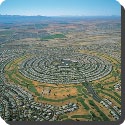 A boomburb is a booming suburb or satellite townships dreamt up by developers. It gives an idea of wealth, a boom. Boomburg is a similar term. These suburbs are usually not complete towns – though they are self-sufficient.
A boomburb is a booming suburb or satellite townships dreamt up by developers. It gives an idea of wealth, a boom. Boomburg is a similar term. These suburbs are usually not complete towns – though they are self-sufficient.
Learn More
Boomburb is a neologism for a large, rapidly growing city that remains essentially suburban in character even as it reaches populations more typical of urban core cities. Like edge city, an older and more widely accepted term, it describes a relatively recent phenomenon in North America.
Boomburbs are defined as incorporated places having more than 100,000 residents that are not the largest city in their metropolitan areas and have maintained double-digit rates of population growth over consecutive censuses. As of the 2000 Census, the United States contained 54 boomburbs, which accounted for over half (51 percent) of the 1990s growth in cities with between 100,000 and 400,000 residents. The boomburbs listed below are based on the populations of cities determined by and definitions of metropolitan areas used in the 2000 Census.
Boomburbs occur mostly in the Southwest, with almost half in California alone. Many boomburbs, especially in the West, are products of master-planned community development and the need to form large water districts. Las Vegas, with its expansive master-planned communities and desert surroundings, contains two boomburbs. By contrast, few boomburbs in the United States are east of the Colorado Front Range and north of Texas and Florida. Even large and rapidly growing Sunbelt metropolitan areas east of the Mississippi, such as Atlanta, lack boomburbs because suburban growth has occurred largely in unincorporated areas or in dozens of small municipalities.
The boomburb phenomenon can also be observed in Canada, in the Greater Toronto Area and the Lower Mainland of British Columbia. These areas, centered on Toronto and Vancouver, are among the fastest-growing in the country. Two other areas experiencing major growth, the Calgary and Edmonton areas, lack boomburbs because much of the growth has occurred within the respective city limits. For the Canadian cities, the 2006 Census applies.
 Kids Portal For Parents India Kids Network
Kids Portal For Parents India Kids Network






